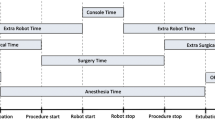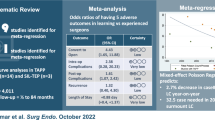Abstract
Introduction
There are numerous reports in the literature documenting high recurrence rates after laparoscopic paraesophageal hernia repair. The purpose of this study was to determine the learning curve for this procedure using the Cumulative Summation (CUSUM) technique.
Methods
Forty-six consecutive patients with paraesophageal hernia were evaluated prospectively after laparoscopic paraesophageal hernia repair. Upper GI series was performed 3 months postoperatively to look for recurrence. Patients were stratified based on the surgeon’s early (first 20 cases) and late experience (>20 cases). The CUSUM method was then used to further analyze the learning curve.
Results
Nine patients (21%) had anatomic recurrence. There was a trend toward a higher recurrence rate during the first 20 cases, although this did not achieve statistical significance (33% vs. 13%, p = 0.10). However, using a CUSUM analysis to plot the learning curve, we found that the recurrence rate diminishes after 18 cases and reaches an acceptable rate after 26 cases.
Conclusions
Surgeon experience is an important predictor of recurrence after laparoscopic paraesophageal hernia repair. CUSUM analysis revealed there is a significant learning curve to become proficient at this procedure, with approximately 20 cases required before a consistent decrease in hernia recurrence rate is observed.

Similar content being viewed by others
References
Skinner DB, Belsey RH (1967) Surgical management of esophageal reflux and hiatus hernia. Long-term results with 1,030 patients. J Thorac Cardiovasc Surg 53:33–54
Stylopoulos N, Gazelle GS, Rattner DW (2002) Paraesophageal hernias: operation or observation? Ann Surg 236:492–500
Cuschieri A, Shimi S, Nathanson LK (1992) Laparoscopic reduction, crural repair, and fundoplication of large hiatal hernia. Am J Surg 163:425–430
Ferri LE, Feldman LS, Stanbridge D, Mayrand S, Stein L, Fried GM (2005) Should laparoscopic paraesophageal hernia repair be abandoned in favor of the open approach? Surg Endosc 19:4–8
Draaisma WA, Gooszen HG, Tournoij E, Broeders IA (2005) Controversies in paraesophageal hernia repair: a review of literature. Surg Endosc 19:1300–1308
Hashemi M, Peters JH, DeMeester TR, Huprich JE, Quek M, Hagen JA, Crookes PF, Theisen J, DeMeester SR, Sillin LF, Bremner CG (2000) Laparoscopic repair of large type III hiatal hernia: objective followup reveals high recurrence rate. J Am Coll Surg 190:553–560
Lal DR, Pellegrini CA, Oelschlager BK (2005) Laparoscopic repair of paraesophageal hernia. Surg Clin North Am 85:105–118
Axelrod DA, Guidinger MK, Metzger RA, Wiesner RH, Webb RL, Merion RM (2006) Transplant center quality assessment using a continuously updatable, risk-adjusted technique (CUSUM). Am J Transplant 6:313–323
Tekkis PP, Senagore AJ, Delaney CP, Fazio VW (2005) Evaluation of the learning curve in laparoscopic colorectal surgery: comparison of right-sided and left-sided resections. Ann Surg 242:83–91
Lerch L, Donald JC, Olivotto IA, Lesperance M, van der WN, Rusnak C, Biberdorf D, Ross A, Hayashi A (2007) Measuring surgeon performance of sentinel lymph node biopsy in breast cancer treatment by cumulative sum analysis. Am J Surg 193:556–559
McCarter FD, Luchette FA, Molloy M, Hurst JM, Davis K Jr, Johannigman JA, Frame SB, Fischer JE (2000) Institutional and individual learning curves for focused abdominal ultrasound for trauma: cumulative sum analysis. Ann Surg 231:689–700
Frantzides CT, Madan AK, Carlson MA, Stavropoulos GP (2002) A prospective, randomized trial of laparoscopic polytetrafluoroethylene (PTFE) patch repair vs simple cruroplasty for large hiatal hernia. Arch Surg 137:649–652
Oelschlager BK, Pellegrini CA, Hunter J, Soper N, Brunt M, Sheppard B, Jobe B, Polissar N, Mitsumori L, Nelson J, Swanstrom L (2006) Biologic prosthesis reduces recurrence after laparoscopic paraesophageal hernia repair: a multicenter, prospective, randomized trial. Ann Surg 244:481–490
Andujar JJ, Papasavas PK, Birdas T, Robke J, Raftopoulos Y, Gagne DJ, Caushaj PF, Landreneau RJ, Keenan RJ (2004) Laparoscopic repair of large paraesophageal hernia is associated with a low incidence of recurrence and reoperation. Surg Endosc 18:444–447
Diaz S, Brunt LM, Klingensmith ME, Frisella PM, Soper NJ (2003) Laparoscopic paraesophageal hernia repair, a challenging operation: medium-term outcome of 116 patients. J Gastrointest Surg 7:59–66
Targarona EM, Novell J, Vela S, Cerdan G, Bendahan G, Torrubia S, Kobus C, Rebasa P, Balague C, Garriga J, Trias M (2004) Mid-term analysis of safety and quality of life after the laparoscopic repair of paraesophageal hiatal hernia. Surg Endosc 18:1045–1050
Khaitan L, Houston H, Sharp K, Holzman M, Richards W (2002) Laparoscopic paraesophageal hernia repair has an acceptable recurrence rate. Am Surg 68:546–551
Luketich JD, Raja S, Fernando HC, Campbell W, Christie NA, Buenaventura PO, Weigel TL, Keenan RJ, Schauer PR (2000) Laparoscopic repair of giant paraesophageal hernia: 100 consecutive cases. Ann Surg 232:608–618
Wu JS, Dunnegan DL, Soper NJ (1999) Clinical and radiologic assessment of laparoscopic paraesophageal hernia repair. Surg Endosc 13:497–502
Mattar SG, Bowers SP, Galloway KD, Hunter JG, Smith CD (2002) Long-term outcome of laparoscopic repair of paraesophageal hernia. Surg Endosc 16:745–749
de Leval MR, Francois K, Bull C, Brawn W, Spiegelhalter D (1994) Analysis of a cluster of surgical failures. Application to a series of neonatal arterial switch operations. J Thorac Cardiovasc Surg 107:914–923
Fraser SA, Feldman LS, Stanbridge D, Fried GM (2005) Characterizing the learning curve for a basic laparoscopic drill. Surg Endosc 19:1572–1578
Dahlberg PS, Deschamps C, Miller DL, Allen MS, Nichols FC, Pairolero PC (2001) Laparoscopic repair of large paraesophageal hiatal hernia. Ann Thorac Surg 72:1125–1129
Champion JK, Rock D (2003) Laparoscopic mesh cruroplasty for large paraesophageal hernias. Surg Endosc 17:551–553
Acknowledgments
Supported in part by an unrestricted educational grant from Covidien Canada and Steinburg-Bernstein Centre for Minimally Invasive Surgery, McGill University.
Disclosures
Dr. Allan Okrainec, Dr. Lorenzo Ferri, Dr. Liane Feldman, and Dr. Gerald Fried have no conflicts of interest or financial ties to disclose.
Author information
Authors and Affiliations
Corresponding author
Rights and permissions
About this article
Cite this article
Okrainec, A., Ferri, L.E., Feldman, L.S. et al. Defining the learning curve in laparoscopic paraesophageal hernia repair: a CUSUM analysis. Surg Endosc 25, 1083–1087 (2011). https://doi.org/10.1007/s00464-010-1321-6
Received:
Accepted:
Published:
Issue Date:
DOI: https://doi.org/10.1007/s00464-010-1321-6




